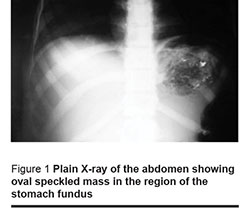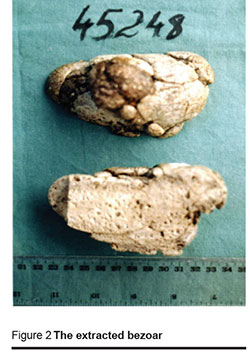M. El Fortia,1 H. Badi,2 Kh. Elalem,3 O. Kadiki4 and Y. Topov5
1Department of Radiology; 2Department of Surgery; 3Department of Internal Medicine; 5Department of Histopathology, Misurata Teaching Hospital, Misurata, Libyan Arab Jamahiriya (Correspondence to M. El Fortia:
4Department of Internal Medicine, Hawari Hospital, Benghazi, Libyan Arab Jamahiriya.
Received: 28/10/04; accepted: 04/04/05
EMHJ, 2006, 12(6): 927-929
Introduction
In the Libyan Arab Jamahiriya, olibanum (frankincense) is commonly recommended as a part of the traditional popular medicine for the treatment of some abdominal disease. Olibanum is used in Misurata as a chewing gum and is swallowed for the treatment of dyspepsia. Bezoars are large conglomerates of vegetables fibres, hairs or concretions of various substances located in the stomach or small intestine of humans and certain ruminant animals [1,2]. There are 3 common varieties of bezoars, trichobezoar, phytobezoar and lactobezoar. Medication bezoars resulting from intake of certain drugs are rare. Phytobezoar is a compact mass of fibres, skins, seeds, leaves, roots or stems of plants that collects in the stomach or small intestine [3]. We report a 17-year-old Libyan female with coeliac disease who developed a gastric bezoar as a result of excessive olibanum intake. To the best of our knowledge, olibanum bezoar has not been reported before in the medical literature.
Case report
A 17-year-old Libyan girl with coeliac disease was admitted to the Department of Internal Medicine in Misurata Teaching Hospital, Libyan Arab Jamahiriya, complaining of intermittent epigastric pain and vomiting for the last 5 months. She had repeatedly swallowed large quantities of olibanum as a treatment for her gastrointestinal disease. On physical examination, the patient appeared pale and cachectic with an evident palpated abdominal mass in the epigastric region.
Plain radiograph showed an oval, speckled structure in projection of the left upper quadrant (Figure 1). Barium meal showed indeterminate material filling the stomach fundus. Abdominal sonography revealed a superficially located broad band of high amplitude echoes along the anterior wall of the mass with sharp, clean posterior acoustic shadowing. Gastroscopy disclosed a large conglomerate filling the stomach fundus. The mass was hard and therefore biopsy was not possible. The patient was treated surgically and the bezoar removed through a vertical gastrotomy incision. The patient tolerated surgery well, the vomiting resolved and she was discharged 2 weeks later. The pathology report revealed a hard stony ovoid conglomerate of 154.46g and 170cm3 volume (Figure 2). It measured 10.5 by 7.5 by 5.5 cm.


Discussion
Gastrointestinal bezoars are a relatively common clinical reality ever since the introduction of truncal vagotomy associated with drainage of gastric resection in the treatment of gastroduodenal peptic ulcer [4]. Cement ingestion resulting in the formation of concretions in stomach is unusual in surgical practice [5]. The gastric accumulation of enteric-coated aspirin tablets due to gastric outlet scarring and impaired gastric emptying has been reported [6].
Olibanum, a gum resin, is reported to possess sedative and analgesic activity. The gum contains different sugars such as D-galactose, D-arabinose, D-xylose and D-mannose. It also contains volatile oils and uronic acids. Olibanum is a common chewing gum among nomads in the outskirts of Misurata city, and swallowing it is recommended for the treatment of gastrointestinal diseases in this area.
Radiologists and surgeons should be aware about this complication. A health education programme is needed in Misurata area to address the issue of olibanum. It should be made clear to the public that swallowing olibanum is harmful but chewing it is not.
References
- Escamilla C et al. Intestinal obstruction and bezoars. Journal of the American College of Surgeons, 1994, 179(3):285–8.
- Sandler RS. Miscellaneous diseases of the stomach. In: Yamada T, ed. Textbook of gastroenterology, 2nd ed. Philadelphia, JB Lippicott Company, 1995:1543–7.
- Emerson AP. Foods high in fiber and phytobezoar formation. Journal of the American Dietetic Association, 1987, 87(12):1675–7.
- Krupp KB, Johns P, Troncoso V. Esophageal bezoar formation in a tube-fed patient receiving sucralfate and antacid therapy: a case report. Gastroenterology nursing, 1995, 18(2):46–8.
- Visvanathan R. Cement bezoars of the stomach. British journal of surgery, 1986, 73(5):381–2.
- Bogacz K, Caldron P. Enteric-coated aspirin bezoar, elevation of serum salicylate level by barium study. Case report and review of medical management. American journal of medicine, 1987, 83(4):783–6.


